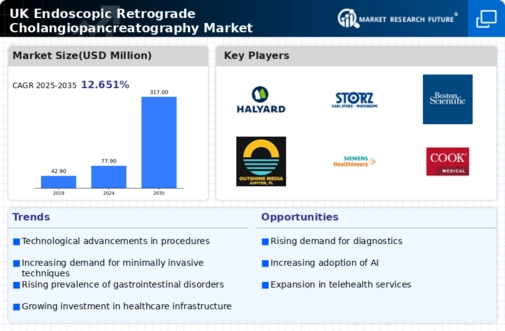Surge in Healthcare Expenditure
The escalation of healthcare expenditure in the UK is another significant driver for the endoscopic retrograde-cholangiopancreatography market. With the National Health Service (NHS) and private healthcare providers investing heavily in advanced medical technologies, there is a notable increase in the availability of endoscopic services. In recent years, healthcare spending has risen by approximately 4-5% annually, reflecting a commitment to improving patient outcomes and expanding access to innovative treatments. This financial support enables hospitals and clinics to acquire state-of-the-art endoscopic equipment, thereby enhancing the quality of care provided. Consequently, the endoscopic retrograde-cholangiopancreatography market is likely to benefit from this upward trend in healthcare investment, as more facilities adopt these procedures to meet the growing demand for effective biliary interventions.
Growing Awareness of Early Diagnosis
There is a marked increase in awareness regarding the importance of early diagnosis of biliary diseases among both healthcare professionals and patients in the UK. This heightened awareness is driving the endoscopic retrograde-cholangiopancreatography market, as early detection is crucial for effective treatment and improved patient outcomes. Educational campaigns and initiatives by health organizations have contributed to this trend, emphasizing the need for timely intervention. As a result, more patients are seeking medical attention for symptoms related to biliary disorders, leading to an uptick in the utilization of endoscopic retrograde-cholangiopancreatography. Furthermore, the integration of advanced diagnostic tools and techniques is likely to enhance the accuracy of these procedures, further solidifying their role in the early diagnosis and management of biliary conditions.
Technological Innovations in Endoscopy
Technological innovations in endoscopy are playing a pivotal role in shaping the endoscopic retrograde-cholangiopancreatography market. The introduction of advanced imaging modalities, such as high-definition endoscopes and narrow-band imaging, has significantly improved the visualization of biliary structures. These innovations not only enhance the accuracy of diagnoses but also facilitate more effective therapeutic interventions. In the UK, the adoption of these cutting-edge technologies is on the rise, as healthcare providers seek to improve patient outcomes and streamline procedural workflows. Additionally, the development of minimally invasive techniques is likely to attract more patients to undergo endoscopic retrograde-cholangiopancreatography, as they offer reduced recovery times and lower complication rates. This trend suggests a promising future for the market, driven by continuous advancements in endoscopic technology.
Increasing Incidence of Biliary Disorders
The rising prevalence of biliary disorders, such as cholangitis and choledocholithiasis, is a key driver for the endoscopic retrograde-cholangiopancreatography market. In the UK, the incidence of these conditions has been steadily increasing, leading to a greater demand for diagnostic and therapeutic procedures. According to recent health statistics, biliary disorders affect approximately 10-15% of the population, necessitating effective treatment options. This growing patient population is likely to propel the demand for endoscopic retrograde-cholangiopancreatography, as it is a preferred method for managing these disorders. Furthermore, advancements in imaging techniques and endoscopic tools enhance the efficacy of these procedures, making them more appealing to healthcare providers. As a result, the endoscopic retrograde-cholangiopancreatography market is expected to experience significant growth in response to the increasing incidence of biliary disorders.
Regulatory Support for Advanced Procedures
Regulatory support for advanced medical procedures is emerging as a crucial driver for the endoscopic retrograde-cholangiopancreatography market. In the UK, regulatory bodies are increasingly endorsing the use of innovative endoscopic techniques, which enhances the credibility and acceptance of these procedures among healthcare providers. This support is reflected in the streamlined approval processes for new technologies and techniques, allowing for quicker integration into clinical practice. As a result, hospitals and clinics are more inclined to adopt endoscopic retrograde-cholangiopancreatography as a standard practice for managing biliary disorders. Furthermore, the establishment of safety guidelines and best practices by regulatory authorities contributes to the overall confidence in these procedures, potentially leading to increased patient referrals and a growing market presence.

















Leave a Comment